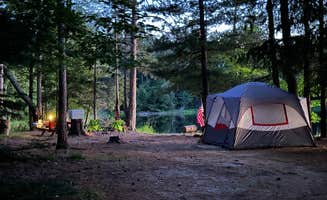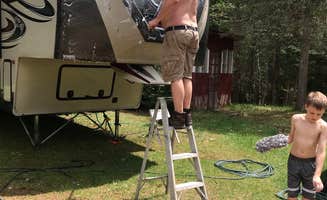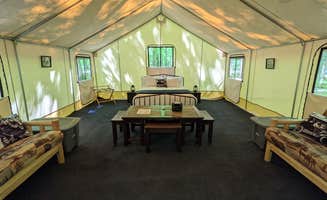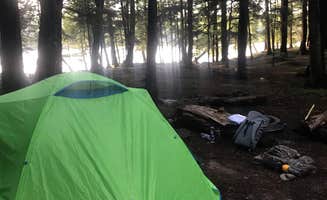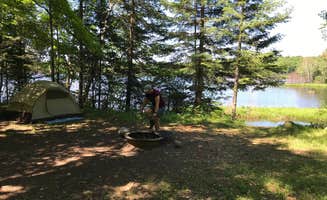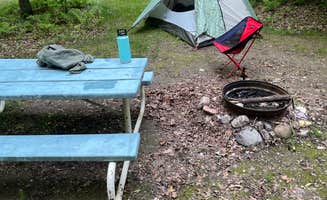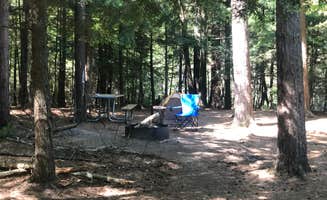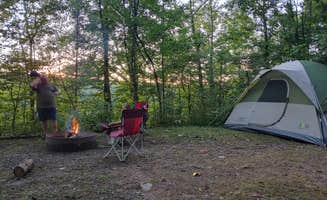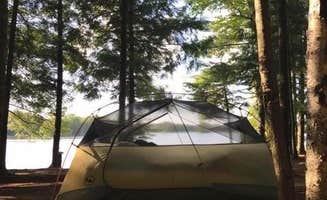Dispersed camping opportunities surround the Three Lakes area within the Chequamegon-Nicolet National Forest at elevations ranging from 1,600-1,700 feet. The region contains over 20 small lakes within a 10-mile radius, creating numerous waterfront camping options. Fall temperatures regularly drop below freezing by late September, requiring proper cold-weather gear for autumn camping trips.
What to do
Fishing from shore or small craft: The backcountry sites in Chequamegon-Nicolet National Forest provide direct lake access for anglers. "This is a huge campsite on a dead end road... There is a sandy beach on a small lake full of fish," reports Kay K. who appreciated the fishing opportunities from shore.
Leaf-peeping in fall: Mid-September through October offers prime fall color viewing when maples, birch and aspen trees transform the forest. The changing leaves create colorful reflections on lake surfaces throughout the region. "The morning greeted us with a misty fog and raining leaves. After breakfast the fog burned off and the mirror surface lake showed her magic," writes Max S. about his experience at Stevens Lake Campground.
Wildlife watching: The quiet campgrounds provide opportunities to observe deer, porcupines, and occasionally rare white deer. "We were lucky enough to see a white deer," notes Liz D. who stayed at Boulder Junction, adding that despite challenging mosquitos, they "had fun exploring in the woods."
What campers like
Secluded lakefront sites: Many campers praise the privacy of single-site lake access. "This is a huge campsite on a dead end road... There is a sandy beach on a small lake full of fish. The Sam Cambell trail is right next door, it's a nice walk to another tiny lake," explains Kay K. about her experience in the national forest.
Foggy morning lake views: Early risers appreciate the misty lake conditions common in the cooler months. At Stevens Lake Campground, one visitor described how "the morning greeted us with a misty fog and raining leaves. After breakfast the fog burned off and the mirror surface lake showed her magic."
Old-growth forest surroundings: The mature trees provide both aesthetic and practical benefits for tent campers. "A lovely area with a good balance of open space and tree cover," notes Danielle A. about Sylvania Wilderness Backcountry Camping, adding that "the area is covered in soft pine duff" which creates comfortable tent padding.
What you should know
Site access varies widely: Some sites require significant hiking or paddling to reach. "We rolled in at dark and were enchanted by trees, falling leaves and mystic lake. There aren't many spots, but they all quintessential WI," reports Max S. about Stevens Lake Campground, noting that "poor cell service for AT&T" should be expected.
Water availability limitations: Most dispersed sites lack potable water. At Stevens Lake Campground, "free water is available via a hand pump," which is an uncommon amenity for backcountry sites in the region.
Site finding challenges: Some campgrounds have limited signage, making navigation difficult. Hilary S. explains about Sylvania Wilderness: "despite the site description saying that it had easy access to trails, we were not able to find a trail leading to the site on the way in, or on the way out of camp. We ended up walking up towards where the trail goes between Crooked and Mountain Lakes and bushwhacked along the shore."
Tips for camping with families
Double-book adjacent sites: For the best tent camping near Three Lakes, Wisconsin with families, consider reserving multiple sites. "Most sites in Sylvania are 2 sites very near to each other... My advice is to book both sites for the nights you're staying. At $15 a night per site, it still ends up being a cheap investment for peace and quiet," recommends Jess R.
Weather flexibility planning: Northwoods weather changes rapidly, especially in spring and fall. One Boulder Junction camper reports they "had such a wonderful week" despite challenging conditions, explaining: "The weather was a bit cold on Lake Superior and our picnic was ruined. However we had a great laugh making sandwiches in the car in a middle of a rain storm."
Insect preparation: Mosquitoes can be problematic, particularly in June and July. "Mosquitos were horrible but we managed! Thankfully we had our bug rackets to fry those suckers," notes Liz D. who camped at Point of View Lake Resort during summer.
Tips from RVers
Parking limitations: While most sites accommodate tents only, some allow trailer parking nearby. "The parking area is huge so one could fit a trailer or pop up there," notes Kay K. about a Chequamegon-Nicolet National Forest site, though camping itself remains tent-only with a short walk to the site.
Electricity options: Limited electrical hookups exist at select campgrounds. "If you are looking for something with tons of amenities, look elsewhere. The basic amenities are here, picnic table, fire pit, bath house with showers within walking distance, electrical (30amp) and water hookups, but don't expect them to be 5 star quality," explains Luis about Moen Lake Campground.
Firewood regulations: Wisconsin's beetle containment rules restrict outside firewood. "Apparently there have been beetle issues in Wisconsin and most campgrounds require you to buy your firewood locally or on-site. The owner was very generous with the size of the stacks we bought," reports Luis from Moen Lake.


